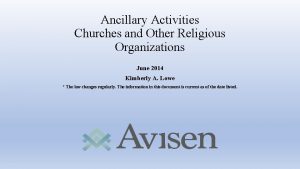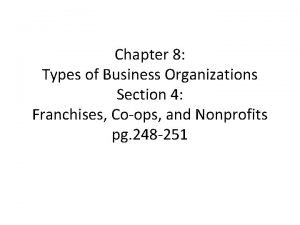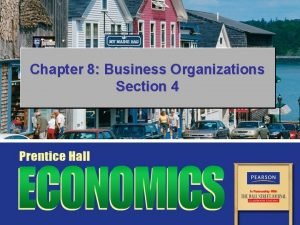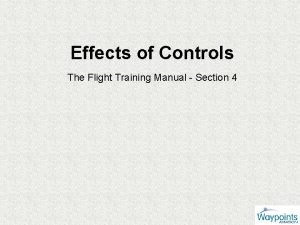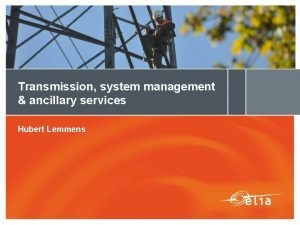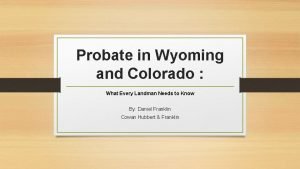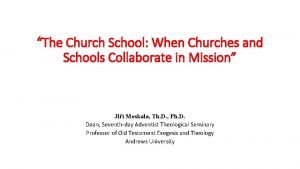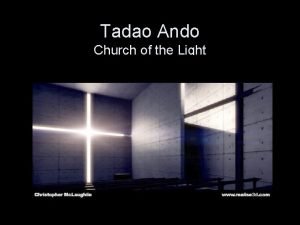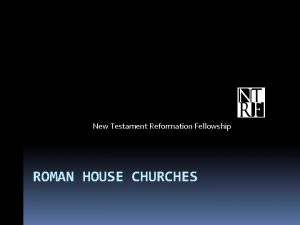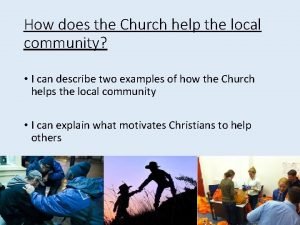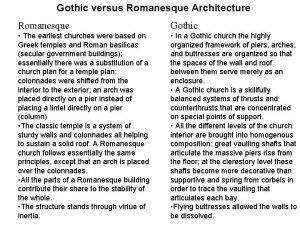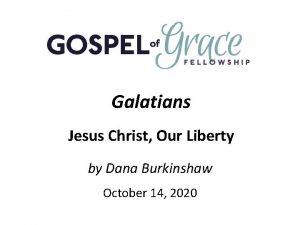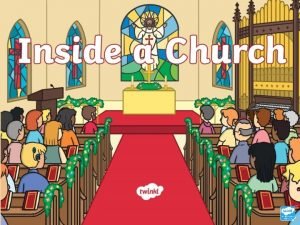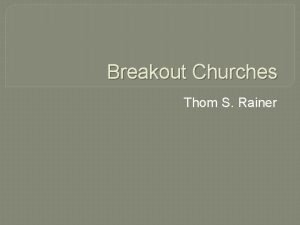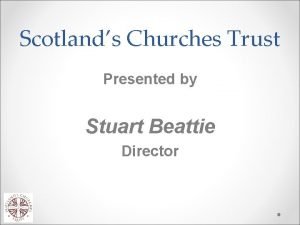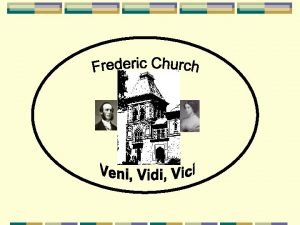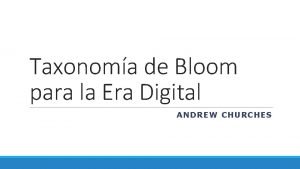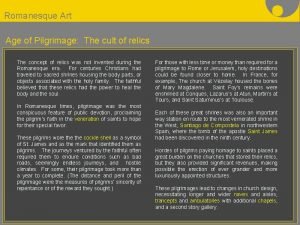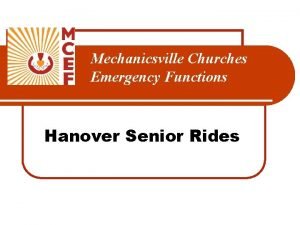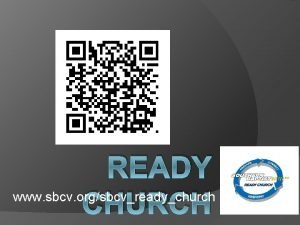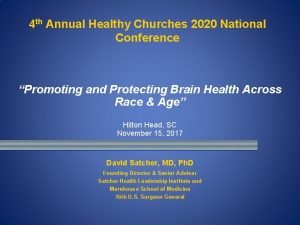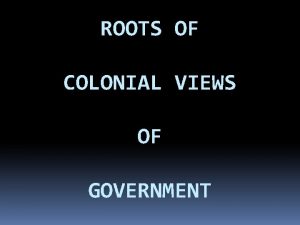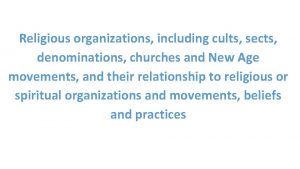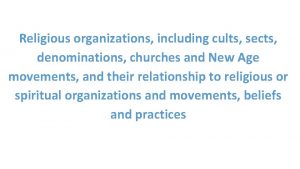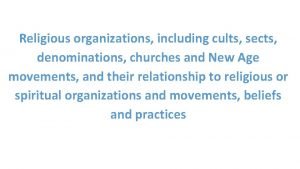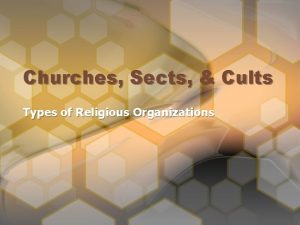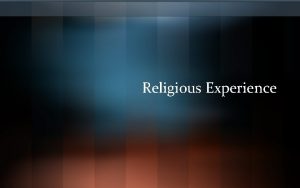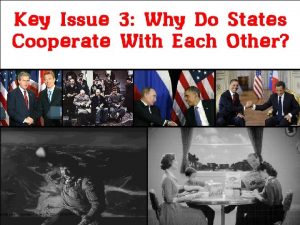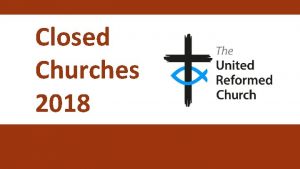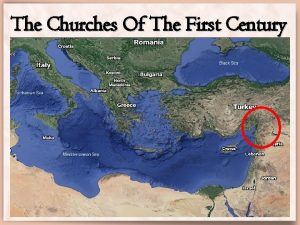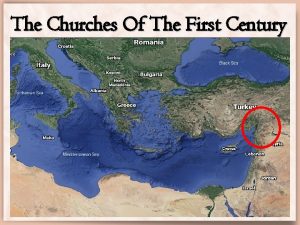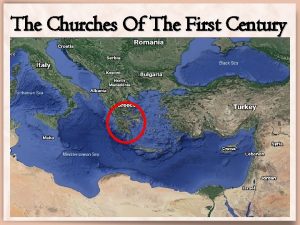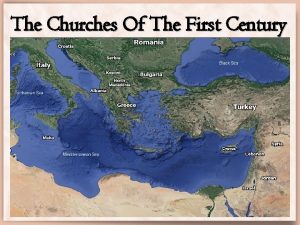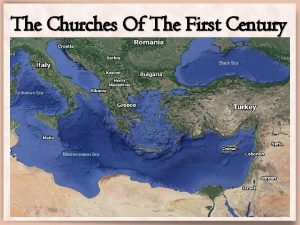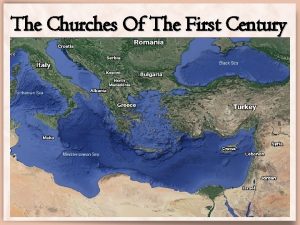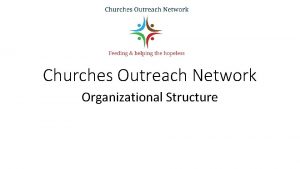Ancillary Activities Churches and Other Religious Organizations June






































- Slides: 38

Ancillary Activities Churches and Other Religious Organizations June 2014 Kimberly A. Lowe * The law changes regularly. The information in this document is current as of the date listed.

Overview • What are Ancillary Activities? • What are the areas of concern and why? • What options are available for ancillary entities? • Can or should the related organizations interact or overlap? • How can or should the related organizations interact or overlap?

What are Ancillary Activities? Activities undertaken by a church or a religious organization that are in addition to or outside the traditional activities of a church or religious organization

What are Ancillary Activities? • Primary purpose • Complimentary to primary purpose • Parishioner Driven • Additional/Sustainable

Primary Ancillary Activities • Outgrowth of church activity: • School • Religious Training • Service Activities • Mission Work • Youth Ministry • Meals on Wheels program • Do not necessarily give rise to needing another entity

Complimentary • Adds value for to the membership • allows the church or religious organization to deepen its relationship with its parishioners or otherwise meet the demands of its membership • creates a stickiness between the church and its parishioners • Enhances religious services

Complimentary • Classic Examples • School • K-12 private school with religious overlay (for children of members) • Hospital • Serving the poor • Church Camp • Pre-K child care

Complimentary • Modern Examples • • Online educational service to assist with homeschooling Senior Housing Development (open to all) Musical Group that tours and records music Art Gallery Coffee Shop Store Corporate Retreat Center

Parishioner Driven • Activities that grow out of the community of the parish and start at the “church” • When people get together great things happen • Institute of Agriculture – group of parishioner with an interest in sustainable agriculture teamed with Uof. M to form at joint venture with a country in Africa

Revenue Generation • Using the assets of the church to generate revenue – capacity • May only be “thematically” related to the church and its activities

Revenue Generation • Publishing Operations • Amusement Parks • Renting out unused school buildings • Parking lot • Workout facility • Transportation Services • Event Facilities

Ancillary Activity • Anything can be parceled into a separate “activity” • What should we really worry about and why?

Questions to Consider • Why does the church want to own, operate or undertake the activity? • How does the church plan to fund these activities? • How does this activity fit into the church’s primary purpose (of being a church)? • Who is going to operate and control this activity? • Does or can this activity in anyway implicate or impact the church’s tax-exempt status as a church?

What Keeps Me Up at Night • Improperly structuring the legal, tax and governance structures of these Ancillary Activities can have adverse legal and tax consequences! • Liability Exposure • Attribution • UBIT

Liability Exposure • Ancillary activities could give rise to liabilities that would erode church assets • Classic parent/subsidiary relationship to make sure the “risks” are partitioned off • May need to shield the church assets from financial risk associated with church • Turn building into a historic site.

When the IRS Can Look Under the Covers • The IRS may audit a church if it reasonably believes that: • an organization claiming to be a church or convention or association of churches may not qualify for exemption, • may be carrying on an unrelated trade or business (within the meaning of IRC § 513), • may otherwise be engaged in taxable activities or • may have entered into an IRC § 4958 excess benefit transaction with a disqualified person.

UBIT (unrelated business income tax) • IRC Section 512 provides that a tax-exempt organization’s revenue generating activities will be subject to UBIT if: • the income is derived from a trade or business. • Trade or business generally includes any activity carried on for the production of income from the sale of goods or performance of services. • the trade or business is “regularly carried on” by the organization. • A business activity will be considered “regularly carried on” if it is frequent and continuous, and the manner in which the business is pursued is generally similar to comparable commercial activities of nonexempt organizations. • the business activity is not considered “substantially related” to the organization’s exempt purpose. • A business activity will be considered substantially related if it contributes importantly to an organization’s exempt function. • Treas. Reg. § 1. 513 -1(c).

Attribution • Treating a “person” as owning an interest in a business that is not actually owned by that person. • Attribution may result from family or business relationships. • Controlled Group

Controlled Group • Definition section 414(b) & (c) of IRC • Defines a controlled group as a combination of two or more corporations that are under common control within the meaning of section 1563(a). • Parent-Sub or Brother/Sister

Parent-Subsidiary • A parent-subsidiary controlled group exists when one or more chains of corporations are connected through stock ownership with a common parent corporation; and • 80 percent of the stock of each corporation, (except the common parent) is owned by one or more corporations in the group; and

Brother-Sister • A brother-sister controlled group is a group of two or more corporations, in which five or fewer common owners (a common owner must be an individual, a trust, or an estate) own directly or indirectly a controlling interest of each group and have “effective control” • Controlling interest - 1. 414(c)-2(b)(2) – generally means 80 percent or more of the stock of each corporation (but only if such common owner owns stock in each corporation); and • Effective control – 1. 414(c)-2(c)(2) – generally more than 50 percent of the stock of each corporation, but only to the extent such stock ownership is identical with respect to such corporation. • With a non-stock entity, the concept of control relates to governance right to elect board and control actions of the entity****

*** • This concept may look for familiar if you are familiar with supporting organizations: • A supporting organization is classified as a Type I, Type II or Type III supporting organization based on the type of relationship it has with its supported organization(s).

Type I Supporting Organization • Must be operated, supervised or controlled by its supported organization(s): • power to regularly appoint or elect a majority of the directors. • The relationship between the supported organization(s) and the supporting organization is sometimes described as similar to a parent-subsidiary relationship.

Type II Supporting Organizations • Must be supervised or controlled in connection with its supported organization(s): • majority of the directors or trustees of the supported organization(s) serve as a majority of the trustees or directors of the supporting organization. • The relationship between the supported organization(s) and the supporting organization is sometimes described as similar to a brother-sister relationship.

Type III Supporting Organizations • Not controlled. • Must be responsive to the needs and demands of, and must constitute an integral part of or maintain significant involvement in, their supported organizations. • Type III subject to a notification requirement, and a separate responsiveness and integral part tests.

What are the Options? • Operates under the Church as an activity of the church • Unincorporated association • Separate entity options • • Nonprofit Limited Liability Company (322 B soon to be 322 C) Nonprofit corporation 317 A For profit corporation 302 A Limited Liability Company • Taxation Options • Separate tax-exempt organization (that files a 990) • Stands alone completely • Supporting Organization – Type I, II or III • Wholly-owned LLC disregarded for tax-purposes • Taxable nonprofit • Investment in a for-profit operation

Questions Revisited • Why does the church want to own, operate or undertake the activity? • How does the church plan to fund these activities? • How does this activity fit into the church’s primary purpose (of being a church)? • Who is going to operate and control this activity? • Does or can undertaking this activity in anyway implicate or impact the church’s tax-exempt status as a church?

Overlap • The answers to the questions and the concerns regarding liability, attribution and UBIT dictate the answer to this question • Gating question for the analysis is the activity charitable (eligible to obtain tax-exemption on its own) • Work threw some examples to determine

317 Governance Options • Membership structure • Church sole or a member • Members elect board of directors • Self-perpetuating board structure • Church “appoints” all board members • Church “appoints” 50% of the board members • Church “appoints” fewer than 50% of board; rest of the board is “independent” of church leadership

LLC Governance Structure • Church sole member of LLC • Disregarded for tax purposes • This option should only be used for primary purpose activities or complimentary activities that clearly have been determined to not result in UBIT (rental income from renting out unused space to for-profit business) – know your UBIT rules well!!!!

Primary Ancillary Activities • Outgrowth of church activity: • School • Religious Training • Service Activities • Mission Work • Youth Ministry • Meals on Wheels program • Do not necessarily give rise to needing another entity

Complimentary • Modern Examples • • Online educational service to assist with homeschooling Senior Housing Development (open to all) Musical Group that tours and records music Art Gallery Coffee Shop Store Corporate Retreat Center

Parishioner Driven • Activities that grow out of the community of the parish and start at the “church” • When people get together great things happen • Institute of Agriculture – group of parishioner with an interest in sustainable agriculture teamed with Uof. M to form at joint venture with a country in Africa

Revenue Generation • Publishing Operations • Amusement Parks • Renting out unused school buildings • Parking lots • Workout facility • Transportation Services • Event Facilities

Examples • Musical Group • Publishing House • Senior Housing

Music Group • Related to church purpose or not? • Yes, do you need a separate entity? • Where do the music rights sit? • What if the group samples someone and is sued for copyright infringement? • Where does the revenue sit? • No, is the activity charitable (tax-exempt) or not? • Yes, supporting organization that files its own 990

Music Group • Related to church purpose or not? • No, is the activity charitable (tax-exempt) or not? • Yes, how will it be funded? • Church, • supporting organization that files its own 990, Type I, II or III • Other public charity funders and its own activities • Stand-alone nonprofit but will need to determine church relationship

Music Group • Related to church purpose or not? • No, is the activity charitable (tax-exempt) or not? • No, it’s a money generating business that is not charitable • Taxable 317 A with a 50 percent or less “control” by the church – board structure versus member structure (church appoints 50 percent of board and other 50 are appointed or made up of unrelated individuals) • Any for-profit entity but church is just an investor and need to watch the attribution and UBIT issues.
 Ancillary activities
Ancillary activities Chapter 8 section 4
Chapter 8 section 4 Chapter 8 section 4 other organizations
Chapter 8 section 4 other organizations What are industrial estates
What are industrial estates Descriptive categories for wisc-v
Descriptive categories for wisc-v Effects of controls flying lesson
Effects of controls flying lesson Ancillary area
Ancillary area Ancillary documents
Ancillary documents Ancillary charge eon
Ancillary charge eon Ancillary facilities construction
Ancillary facilities construction Ancillary probate colorado
Ancillary probate colorado Aaapl
Aaapl Churches and schools working together
Churches and schools working together The diagram shows the position of two churches a and b
The diagram shows the position of two churches a and b Outdoor sports name
Outdoor sports name Support activities and primary activities
Support activities and primary activities Examples of primary activities
Examples of primary activities Light church tadao ando
Light church tadao ando House churches in the new testament
House churches in the new testament What is the role of the church in the local community
What is the role of the church in the local community Romanesque vs gothic architecture
Romanesque vs gothic architecture Where was galatia in the bible
Where was galatia in the bible Nice churches
Nice churches The churches the apostles left behind
The churches the apostles left behind Breakout churches thom rainer
Breakout churches thom rainer Scotland's churches trust
Scotland's churches trust Scottish churches housing action
Scottish churches housing action Historical churches thesis statement
Historical churches thesis statement Andrew churches taxonomia de bloom
Andrew churches taxonomia de bloom Hailey comet cult
Hailey comet cult D m v r e c o r d c h e c k
D m v r e c o r d c h e c k Sbcv churches
Sbcv churches Healthy churches 2020
Healthy churches 2020 The statement of cash flows helps users
The statement of cash flows helps users Other initiated self repair example
Other initiated self repair example Religious symbolism in the old man and the sea
Religious symbolism in the old man and the sea Colonial views on government tree
Colonial views on government tree Cognitive and non cognitive religious language
Cognitive and non cognitive religious language If i profane with my unworthiest hand
If i profane with my unworthiest hand
